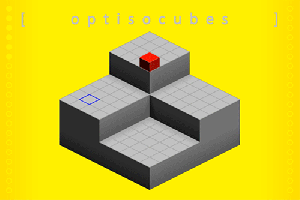I’ve just finished (or at least made publicly available) my next game, optisocubes.
This idea started when I saw a sticker on a friend’s skateboard, it was an optical illusion where two isometric cubes drawn on top of each other can appear to be both solid and hollow. It looked a little like this:
From there I started playing with drawing simple isometric shapes, and trying to get a cube to rotate and animate.
As you can see my first efforts where not perfect. The cube appears to distort and change shape when it rotates.
After reading up a little more on isometric game art and having another think about how I handled my shapes, I managed to improve the rotation some more and started on the between level animations.
From here it was a matter of designing the levels and making tweaks.
Early feedback I got from Zhan (@ZhanCat) helped me balance the early levels, really slowing them down to ease players into the control scheme and the methods for solving the puzzles.
I got some really useful control feedback from Aubrey (@HilariousCow) . You’ll notice if you tap the movement button the cube will rotate back to its starting position. This allows the player the change their mind if they press the wrong button.
I took the game to a London Indie Pub meet, where a few people gave the game a go. I think I’ve definitely found it’s not for everyone. Some people can’t see their way around the optical illusion as well as others. This was even with the additional gradients I added to give a greater perception of depth:
I really go bugged down designing the levels. My method was to generate random patterns and then try to move round the cubes in interesting ways. Once I got them to a specific point, I then put the targets there and attempted to level again to see how difficult it was.
Having to go over the levels again and again to test them was not the most exciting, but it’s interesting to see that there are still a couple of the later levels that I have to re-workout how to solve.
The final piece of feedback I implemented was allowing the game to keep track of the players progress. This means that players can leave the game and come back without feeling they have to do everything all over again.
If you do try it, let me know, I’d love to hear some feedback. Also if you manage to finish it send me a screen shot, I’m interested to see how many moves it takes.
Play the game here.
Tweet #optisocubes


Pingback: Optisocubes – 30 days later and a Curious Event | Practice Theory Play